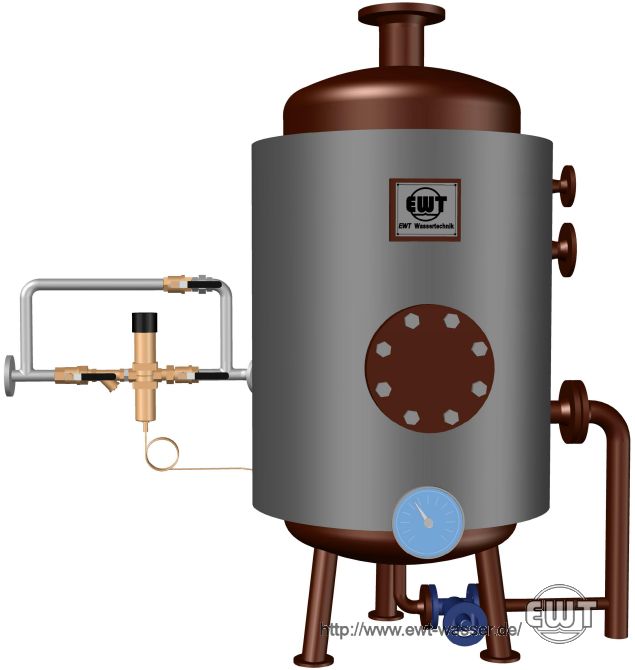

← Home • Products • Flash Vessel ↓ Summary • Design Example • Applications • Technical Data • Downloads
A boiler water flash vessel (also: blow-down vessel, blow-down receiver, flash box) is a vessel for phase separation, cooling and discharge of hot boiler water from boiler blow-down or draining.
In case of mainly adiabatic pressure reduction of boiling water, the resulting reduction of the boiling point enthalpy will cause the water to flash, meaning partial evaporation resulting in a two-phase water-steam-mixture. For safety reasons and in order to comply with waste water regulations, pressure reduction down to atmospheric pressure, phase separation, and cooling of the liquid phase are all strictly required before discharging the boiler blow-down into a public sewer network.
The cooling of the liquid phase is usually accomplished either directly inside the flash vessel by mixing with cooling water, or with a liquid-liquid heat exchanger or blow-down cooler for heat recovery located downstream of the flash vessel. In case of flash vessels operating at atmospheric pressure, the steam phase is discharged directly into the atmosphere. In case of flash vessels operating at higher than atmospheric pressure, a further use of the steam phase for heat recovery is possible, for example by sparging it into the boiler feed water tank of the →deaeration plant.

Atmospheric boiler water flash vessel and blow-down cooler for an industrial shell boiler.
| boiler water mass flow, continuous | available from approx. 50 up to 50 000 kg/h ≈ 0.015 ... 15 kg/s | |||
| boiler water mass flow, short-term | available up to approx. 450 000 kg/h ≈ 125 kg/s | |||
| boiler water temperature | ≤ 374 °C; significant for flash vessel design | |||
| flash steam phase portion | approx. 10% ... 50%, depending upon the boiler water temperature | |||
| operating pressure |
≤ 0.5 bar, atmospheric flash vessel ≤ 4 ... 10 bar, pressurized flash vessel |
|||
| operating temperature |
≤ 111 °C, atmospheric flash vessel ≤ 150 ... 185 °C, pressurized flash vessel |
|||
| cooling water mass flow | approx. 1.5× ... 5× boiler water mass flow | |||
| discharge temperature | usually ≤ 35 ... 50 °C | |||
| recommended cooling water quality | total suspended solids (TSS) | < 5 mg/L | ||
| pH value | 6.5 ... 8 | |||
| electrical conductivity | ≤ 1500 μS/cm | |||
| water hardness | ≤ 0.5 ... 2.5 mmol/L | |||
| iron | < 0.3 mg/L | |||
| code for pressure vessel manufacturing |
• not specified, "sound engineering practice" • EN 13445 • AD 2000 • VGB-S-110-R-00 (replacement for VGB-R 110 L) • GOST R (export certificate for the Russian Federation) |
|||
| material options | pressure vessel |
• carbon steel (e.g. S235JR, P265GH) • low alloy steel (e.g. 16Mo3) |
||
| pipelines |
• carbon steel (e.g. P235TR2, P235GH) • low alloy steel (e.g. 16Mo3) • stainless steel (e.g. 1.4404, 1.4541) |
|||
| valves |
• brass (e.g. CW710R) • grey cast iron (e.g. 5.1301) • spheroidal cast iron (e.g. 5.3103, 5.3106) • cast steel (e.g. 1.0619) • stainless steel (e.g. 1.4401, 1.4408) |
|||
| gaskets |
• ethylene propylene diene monomer rubber (EPDM) • polytetrafluoroethylene (PTFE) • NBR composite • graphite composite |
|||
| control options | level control |
• atmospheric discharge, not controlled • mechanical, continuous (P control) • electric, intermittent (on/off control) • electric, continuous (PI, PID, or 3-point control) |
||
| Temperaturregelung |
• mechanical, continuous (P control) • electric, intermittent (on/off control) • electric, continuous (PI, PID, or 3-point control) |
|||
2018-05-05 • water treatment made in Germany • Company Information • Privacy